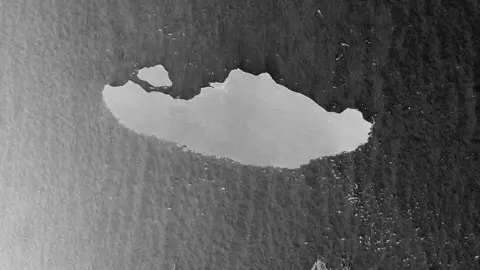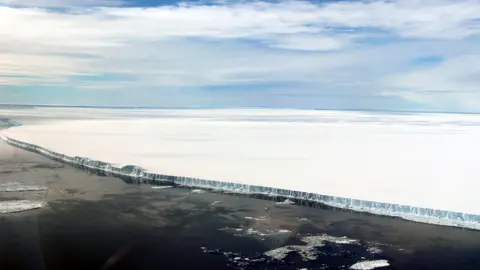Antarctica's A-68: Is the world's biggest iceberg about to break up?
 Copernicus/Esa/Sentinel-1
Copernicus/Esa/Sentinel-1The world's biggest iceberg, A-68, just got a little smaller.
At around 5,100 sq km, the behemoth has been the largest free-floating block of ice in Antarctica since it broke away from the continent in July 2017.
But on Thursday, it dropped a sizeable chunk measuring about 175 sq km.
The iceberg is currently moving north from the Antarctic Peninsula. Having entered rougher, warmer waters - it is now riding currents that should take it towards the South Atlantic.
Prof Adrian Luckman, who's been following A-68's progress, said the new fracture could mark the beginning of the end of this icy giant.
"I am continually amazed that something so thin and fragile has lasted so long on the open sea," the Swansea University researcher told BBC News.
"I suspect that the final break-up is now starting, but the ensuing fragments will probably be with us for years."
Evidence of Thursday's split came via a radar image acquired by the European Union's Sentinel-1 satellite.
 NASA/John Sonntag
NASA/John SonntagA-68's name comes from a classification system run by the US National Ice Center, which divides the Antarctic into quadrants. Because the berg broke from the Larsen C Ice Shelf in the Weddell Sea, it got an "A" designation. "68" was the latest number in the series of large calvings in that sector.
Properly, we should refer to the berg as A-68A - that's because subsequent breakages also get their own related name. A-68B was dropped early in the life of the main berg. This new chunk will almost certainly get the designation A-68C.
Were there indications that this particular corner would come off? "Not that I have seen. I've been keeping an eye on progress, but mostly it's been attrition of small flakes from all around," said Prof Luckman.
When first calved in 2017, A-68 was close to 6,000 sq km in area, with an average thickness of about 190m.
For months it appeared to catch on the seafloor and didn't move very far. But eventually it spun around and picked up pace as it drifted northwards. This past austral summer saw the giant break free of the persistent sea-ice that clogs the Weddell Sea - a significant development because it has exposed A-68 to much greater swells. Its structure is now under more stress and further splits should be expected.
It's currently travelling past the South Orkney Islands which form the far tip of the Antarctic Peninsula. Currents should then throw it in the general direction of South Georgia and the South Sandwich Islands.
How much longer A-68 can maintain its present integrity is anyone's guess. But even if it does suffer a major fragmentation event, the individual icy blocks could persist well into the 2020s before melting away.

[email protected] and follow me on Twitter: @BBCAmos
